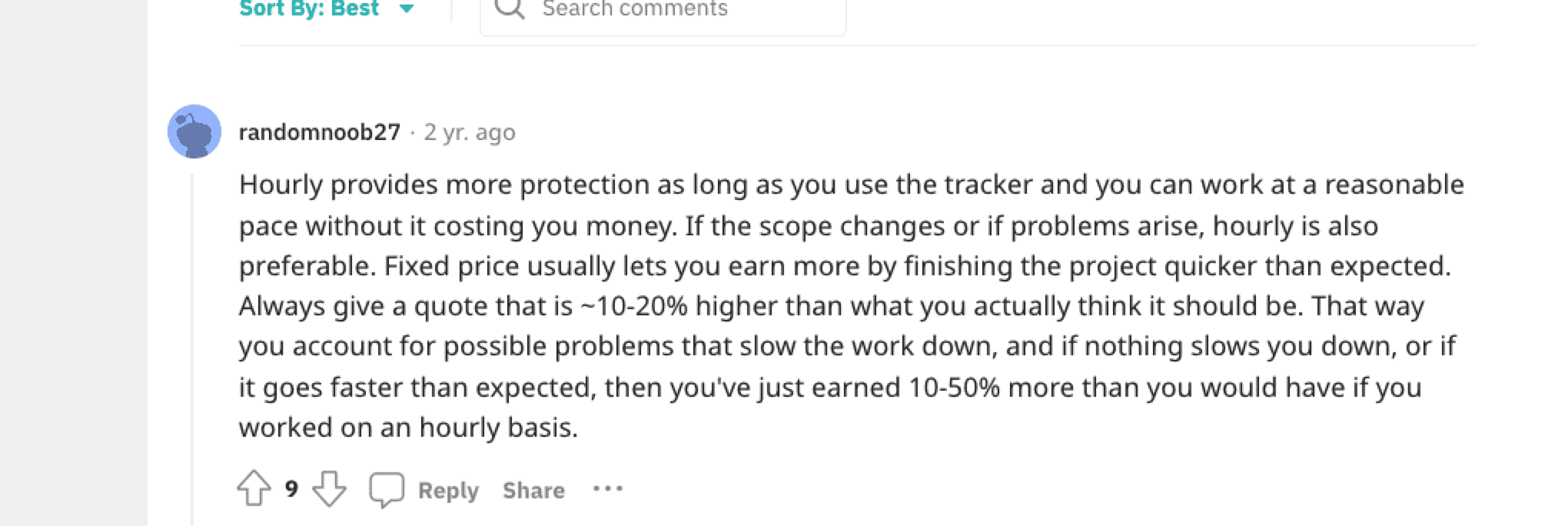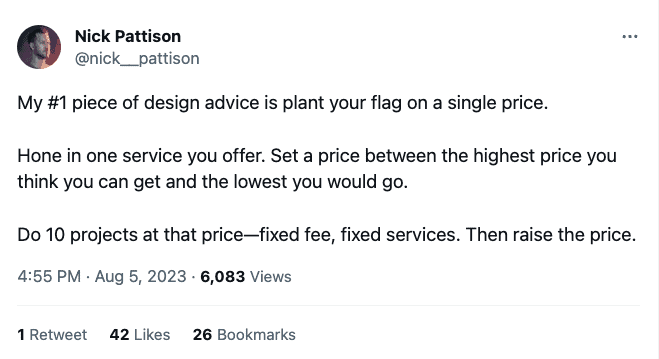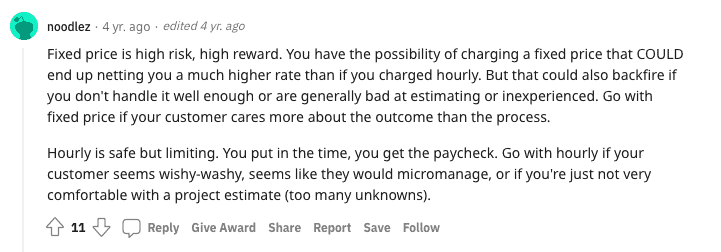Time and materials vs. fixed fee – which type of contract wins?
That depends on many factors, including project needs, client expectations, or business strategies.
In this guide, we’ll cover the pros and cons of each and give you tips on when to choose each one.
What is time and materials pricing?
The time and materials (T&M) pricing model is based on hourly billing.
You charge clients based on the actual time spent on a project (multiplied by an agreed hourly rate) plus the final cost of materials used.
For example, say company X hired a web development agency to build them a website. The agency’s hourly rate is $100 for web development work.
It took the agency 50 hours to complete the website design and development. The total cost of materials (stock photos, web hosting, domain registration) was $500.
Under the T&M model, company X would be billed as follows:
- Web development time: 50 hours x $100 per hour = $5,000
- Materials costs: $500
Total project cost: $5,000 + $500 = $5,500
What is fixed-fee pricing?
The fixed-fee pricing model, or flat-fee pricing, is a billing method where you charge a fixed amount for a specific service, regardless of the time or resources used to complete it.
For example, an agency offers a standard website package for small businesses at a flat rate of $5,000.
This includes:
- Initial consultation and project scoping
- Custom website design (5 pages)
- Development and implementation
- Search engine optimization setup
- Training on content management system
- 3 months of support
The agency fixes the price at $5,000 upfront. It doesn’t matter how many hours their team spends on the project or what specific resources they use. The agency absorbs any extra costs above $5,000.
Now let’s compare the two!
Time and materials vs. fixed fee: key differences
Payment
- T&M bills for hours worked and expenses incurred are based on your hourly rate—the final price could differ from your estimate.
- The fixed fee provides an estimated cost for the full project scope that you and your client agree on before you start on the project.
Profitability
- T&M contracts allow you to maximize profits by billing all hours worked at your hourly rate—profitability aligns directly with billable utilization.
- With a fixed fee, your profitability is predetermined. Higher profits require accurately estimating costs and solid budget management. Exceeding budgets lowers profit margins.
Risk
- In T&M, the client assumes the most financial risk if cost and time estimates are exceeded—you get paid for hours worked.
- If a fixed-fee project runs over budget, you take on more risk as your project profits can disappear.
Flexibility
- T&M allows flexibility to change scope and timelines without a significant contract change.
- Fixed fee contracts require renegotiating the entire quoted price if the scope changes.
Incentive alignment
- T&M can incentivize inefficiency or overwork since you bill for hours worked. More hours equals more revenue. But this can potentially strain client relationships.
- Fixed pricing rewards efficiency and cost management, as going over budget directly reduces your profits.
When to choose a time & materials contract
Here are a few situations when a T&M contract might be the better choice:
Scenario #1 – Project scope is likely to change over time
T&M contracts are better suited to projects where the scope is likely to change over time.

For example, say you’re part of the development team working for a startup that needs a new app. The market is changing fast, and you expect to add new features or remove existing ones as new demands emerge.
In this case, a T&M contract is the right choice.
Scenario #2 – There’s a lack of detailed information about the project
Not having access to detailed information about the project can make it difficult to estimate fees and expenses from the start accurately.
For example, if you’re a design agency working with a client that wants to explore different branding design ideas. Since they don’t have a detailed plan for their project and there’s a high risk of scope creep, it’s smart to go for a T&M contract.
Scenario #3 – Highly complex projects
Complex projects often require experimentation, research, and several iterations, making using the fixed price model based on predefined deliverables challenging.
Long-term projects usually go better with a T&M model. For example, a startup hires a design studio to provide an open-ended creative retainer.
The early-stage business needs a brand identity, style guide, packaging, digital/print collateral, and advertising concepts. Given the brand is new, the founders expect the creative directions to evolve rapidly as they test concepts and refine messaging.
The variability makes T&M a better fit than trying to estimate a fixed fee.
When to choose a fixed-price contract
Here are a few situations when a fixed-fee project might be the better choice:
Scenario #1 – When the project has a well-defined scope
If your client has a clear understanding of what they want and the project scope and duration are unlikely to change significantly, then a fixed-fee pricing model is the better option.
For example, installing a solar power system for a home. There are clear guidelines and processes to follow, so the project’s scope is not subject to change.
Scenario #2 – When the project is not too complex
Fixed-fee pricing models are perfect for smaller projects with high predictability and don’t require changes.
For example, a social media marketing agency is hired to amplify brand awareness for launching a new consumer product.
The defined scope of work includes:
- Creating five social media campaign concepts
- Developing content for one campaign—including 20 Instagram posts
- Reporting on impressions, engagement, and lead generation
This is a relatively straightforward social campaign with a clearly defined deliverable set. The lack of complexity means the agency is confident in providing a fixed fee quote.

Scenario #3 – When you know how to estimate project costs accurately
Fixed fee projects are high risk and high reward. You have a good chance of netting more revenue if you know how to estimate project costs accurately.

For example, a digital marketing agency compiles an SEO content strategy for a B2B SaaS client.
The defined scope of work could involve:
- Performing a content audit
- Selecting content topics to target
- Conducting keyword research
- Creating an editorial calendar for the next six months
The agency has in-house solid writing and design capabilities. Based on past content strategy projects, they have high confidence in estimating the time and costs to deliver this SEO strategy.
Scenario #4 — For projects with limited budgets
Clients with a limited or fixed budget may prefer a fixed-price agreement.
For example, a startup that wants to develop a mobile app but has a limited budget. Using a fixed-fee pricing model, they know exactly how much they pay for the project without the risk of exceeding their limited budget.
Having a detailed statement of work (SOW) is critical when using fixed-fee pricing models. The SOW allows you to provide an accurate fixed fee quote based on clearly defined project parameters, milestones, and deliverables.
It also ensures the client understands exactly what is included in the fixed price, with no hidden costs. A strong SOW sets clear expectations upfront for both parties, while giving the client cost predictability.
Now over to you
Whether you go for a time and materials or fixed-fee pricing model, having a trusted partner with you on your journey is good to help track profitability and grow your business.
Toggl Track is just a few clicks away, waiting for you to start stress-free tracking of what your team is doing, when, and how.
Time tracking your team will love and use!
Trusted by 70,000 businesses and over 5 million users worldwide.
Try Toggl TrackWork tools to elevate your productivity – apps for incredibly simple time tracking and effective project planning.


